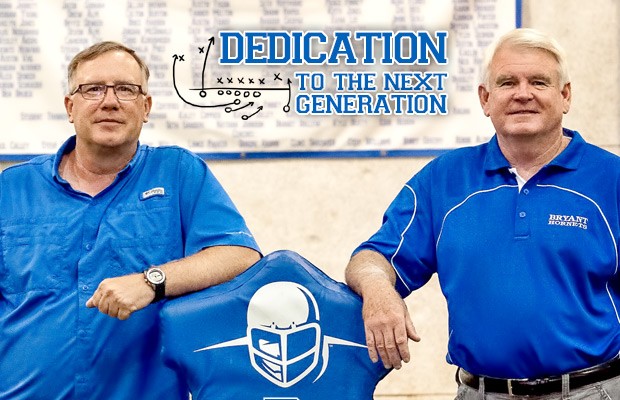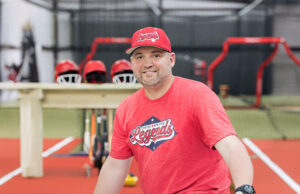Dedication To The Next Generation

A high school coach’s life often involves years of moving job-to-job, especially in the beginning. To look at his resume, it wouldn’t be unusual at to see four, maybe five different moves in the first ten years of his career. To find two coaches within the same program who have stayed for a combined 63 years is nothing short of incredible, but Bryant Hornet assistant coaches Steve Griffith and Brad Stroud can make that claim.
Griffith arrived in Bryant 35 years ago and has held a variety of coaching and teaching positions with the school. He’s a native Arkansan, growing up in Norphlet and attending Southern Arkansas University in Magnolia.
“When I first drove into Bryant in 1981, Reynolds Road was two lanes, and there was only the School, a Pizza Hut, a gas station and a Dairy King,” Griffith said. “We had just moved from 3A to 4A when I came along. We had around 3,500 students.”
Stroud became a Hornet six years later in 1987. He grew up in Little Rock and played ball for McClellan High. After graduating from Harding University in Searcy, he coached at Harding Academy in Memphis for seven years.
“Bryant was a small bedroom community,” he said. “The high school and a few churches were the main institutions in town. Then, when McDonald’s, Wendy’s and Walmart showed up, everything started changing.”
Since then, “change” may be what best describes Bryant. The town continues growing by leaps and bounds, and the school, now one of the largest in Arkansas, has an enrollment of more than 9,000 students.
The high school football game has changed a lot, too. What was once a predominantly run-oriented offensive attack has given way to a spread, pass-oriented game.
“When I started, it was a pro-set with a fullback and tailback,” Stroud said. “You threw the ball, but the running game was typically your first option.”
“The game is a lot more complicated today with a greater mental demand on the kids,” Griffith said. “When I started coaching, an offense might have two or three different formations. If a player went into motion before the snap, you would panic.
“These days, teams will give you anywhere between 20 and 25 different looks in the course of the game,” he added.
Griffith is currently the defensive coordinator for Hornets. Stroud coaches the defensive line and place kickers.
Both coaches will tell you the players are largely the same. “We are talking about 17 year-old boys,” Grifith said. There is, however, one major difference.
“The players are bigger, faster and stronger,” Stroud said. “When I played, if we had someone who was 6’2” 230 lbs., that was a big kid. There are a lot of those.
“We face offensive linemen who are 6’10” 300 lbs. It’s not everyday, but they’re out there,” he added.
Being with the program for such a long time, Coach Stroud and Coach Griffith both remember the Hornets’ lean years on the field. “If we made it into the fourth quarter and were still in the ball game, it was tough because our kids didn’t know how to react,” Stroud said.
However, the Hornets’ fortunes began changing during the 1999 season, under former head coach Daryl Patton. “There was a real change in attitude,” Griffith said. “Daryl came here in 1998, believing the Bryant program could be competitive, despite what others had told him in the past.
“There was a group of seniors who bought into his idea and didn’t want to hear anymore about the history of the Bryant program,” he added.
“The kids really began believing in themselves,” Stroud said. “We won 11 games that year, and it changed mainly because there was an attitude adjustment. We still have that attitude today, and winning only builds confidence.”
Patton left Bryant for the head coaching job at Fayetteville High School. He was replaced by current head coach Paul Calley, and the winning tradition in Bryant has only grown stronger.
“Coach Calley is a very driven guy,” Stroud said. “He’s a true competitor who demands a lot out of his kids, both during the season and in the off-season.”
“Paul has done an incredible job since taking over,” Griffith said. “He has a great rapport with the kids. He really cares about them, and I think they truly understand that.”
Adapting to the changing high school game has kept these two coaching veterans on their toes, and the ever-evolving world of technology has made things easier along the way.
“When I first started coaching, we had 16 mm game film,” Stroud said. “Today we have three cameras working the game,” he added. “I can watch game film in HD on my iPhone or my iPad.”
Another major change has been the use of artificial turf and indoor practice facilities at the high school level. “This was something you often saw in Texas at coaching seminars,” Griffith said. “Now schools of all sizes have them. We do the best we can to get full use out of ours, and it’s great.”
While the game has changed, the athletes have changed, and the technology has changed, both coaches maintain that the reason they still come into work every day hasn’t changed at all–that’s the chance to work with the student athletes, molding them into future leaders.
“I love being around the kids and teaching my classes every semester,” Griffith said. “I enjoy the competitive nature of football and can’t really imagine anything else I would’ve enjoyed doing over 35 years.”
“Every job has its ups and downs, and coaching is no different,” Stroud said. “You’ve got the high’s and the low’s, but winning and working with these young men help.”









0 comments